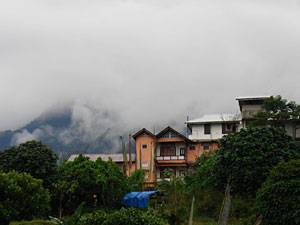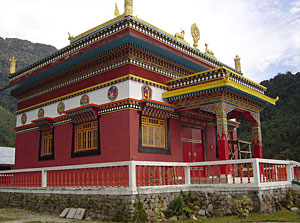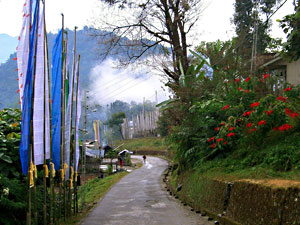|
|
|
Yuksom, Sikkim |
|
|
|
Information about Yuksom |
|
Yuksom
literally means the meeting of three great lamas. These
lamas came from Tibet and established the Nyingmapa
order of Tibetan Buddhism. They also crowned the first
choygal of Sikkim in Yuksom in 1641. Yuksom is also the
entry point of the Khangchendzonga National Park. Yuksom
is the base camp for various trekkers and the mountain
climbing course organized by the Himalayan
Mountaineering Institute. Loveable Yuksom is historic
and charming it’s the main trailhead for the
Khangchendzonga Trek, but lack direct views of the high
mountains. The Community Information Centre offers
internet connection in an unlikely hut near Kathok Lake. |
 |
|
|
|
|
Tourist Attractions in Yuksom
The tourist attractions in Yuksom are Tashi Tenka, Norbugang
Park, Dubdi Gompa and Kathok Wodsallin Gompa.
Tashi Tenka
When Yuksom was Sikkim’s capital, a royal palace complex known
as Tashi Tenka sat on a slight ridge to the south with superb
almost 360 degree views. Today barely a stone remains but the
views are still superb, to find the site take the small path
marked by two crumbling little whitewashed stupas near the
village school. The site is less than five minutes walk away
through tiny Gupha Dara, a sub-hamlet of around a dozen
semi-traditional houses.
Norbugang Park
Norbugang Park contains a prayer house, chorten and the
supposedly original Coronation Throne (Norbugang). Standing
beneath a vast cryptomeria pine it looks something like an
ancient Olympic medal podium made of whitewashed stone. Just
in front is a spooky footprint fused into the stone. This was
supposedly left by one of the crowning lamas: lift the little
wooden guard-plank to see it. From murky Kathok Lake,
anointing waters were taken for the original coronation.
Kathok Wodsallin Gompa
Kathok Wodsallin Gompa near Hotel Tashi Gang exudes a
wonderful Chinatown kitsch and enshrines a big gilded
Padmasambhava statue. Similarly colourful is Ngadhak Changchub
Choling, accessed through an ornate gateway opposite Hotel
Yangri Gang. |
|
|
|
Dubdi Gompa
High above Yuksom, Dubdi Gompa is set in beautifully
tended gardens behind three photogenic, coarsely hewn
Stupa. Established in 1701, it is one of the Sikkim’s
oldest monasteries but the cubic prayer house looks
vastly newer. There’s no resident monk so if you want to
look inside, locate the caretaker before you start the
steep 45-minute climb from Yuksom’s village clinic. The
way rises through thickets of trumpet lilies and some
lovely mature forest.
Kathok Wodsallin Gompa
Kathok Wodsallin Gompa near Hotel Tashi Gang |
 |
|
|
exudes a
wonderful Chinatown kitsch and enshrines a big gilded
Padmasambhava statue. Similarly colourful is Ngadhak Changchub
Choling, accessed through an ornate gateway opposite Hotel
Yangri Gang.
Trekking in Yuksom
The trail to Dzongri and Goecha La heads uphill beyond the
Hotel Tashi Gang, passing a police post where trekking permits
are carefully checked. The route initially follows the Rathong
Valley through unspoilt forest then ascends steeply to Bakhim
(2740 m) and the rustic village of Tsokha (3050 m), where
spending two nights helps with acclimatization. The next stage
climbs to pleasant meadows around Dzongri (4025 m). Consider
another acclimatization day here, spent strolling up to
Dablakang or Dzongri La (4550 m, four-hour round trip) for
fabulous views of Mt. Pandim (6691 m). From Dzongri, the trail
drops steeply to Kochuran then follows the river to Thangsing
(3840 m). From huts here or at Samiti Lake (4200 m), an early
morning assault takes you to head-spinning Goecha La (4940 m)
for those incredible view of Khangchendzonga. Readers have
recommended an alternative viewpoint reached by climbing an
hour up from the left side of Samiti Lake. The return is by
essentially the same route but with short cuts that are
sometimes a little overgrown. Alternatively at Dzongri you
could cut south for about a week following the Singalila Ridge
along the Nepal-Sikkim Border to emerge at Uttarey, from where
public transport runs to Jorethang.
Yuksom to Tashiding Trek
For this long but highly rewarding one-day trek, starting in
Yuksom is easier than coming the other way. No trekking
permits are required. Start down the pathway between hotels
Yangri Gang and Penathang. The most attractive but longest
route leads around behind the Phamrong Falls (heard but not
seen) then rises to Tsong, where Susan Chetri plans a homestay
at her family’s typical half-timbered house. From the terrace
there are terrific views. Look for the blue-framed home
towards the eastern end of the village: it’s on the right side
of the main trail when heading for Tashiding. Beyond Tsong the
trail divides. The upper route leads up fairly steeply to
lonely Hongri Gompa, a small, unusually unpainted ancient
monastery building with a superlative ridge top location.
Local folklore claims the gompa was moved here from a higher
location where monks kept being ravaged by yeti. Till this
point the route is relatively easy to follow, with recently
laid stone grips. But descending from Hongri there are
slippery patches with lurking leeches. At Nessa hamlet,
finding the way can be mildly confusing. A few minutes beyond
in attractive Pokhari Dara (Where a tourist lodge is mooted
beside the sweet little pond), the trails divides again beside
the village shop. Descending takes you the moare direct way to
Tashiding. Continuing high along the ridge brings you to Sinon
Gompa very high above Tashiding. The final approach to that
monastery has some fascinating, ancient mani walls but the
descent to Tashiding is long and steep by the short-cut paths
or almost 10 km of long switchbacks by road. |
|
|
|
Tashiding
Tashiding in West Sikkim was built by the half sister of
Chador Namgyal in 1716 on a spot consecrated by Guru
Rimpoche, between the Ratong and Rangit rivers on a
ridge overlooking both. It is considered to be the most
sacred Chorten in Sikkim the sight of which is thought
to bring blessings. Little Tashiding is just a single,
sloping spur street forking north off the Yuksom-Legship
road, but its south-facing views are wide and
impressive. Walking 400 m south from the junction
towards Legship, a series of atmospheric mani walls and
brightly photogenic Tibetan inscriptions will take you
to a colourful gateway at the Km 14 post. From here an
obvious if sometimes slippery moss-stone footpath leads
somewhat |
 |
|
|
steeply up to
the ancient Tashiding Gompa in around 40 minutes. Founded in
1641 by one of the three Yuksom lamas, the monastery’s five
colourful religious buildings are strung out between more
functional monks quarters. The giant-sized prayer wheel with
Tibetan script is picked out in gilt. Beautifully
proportioned, the four-storey main prayer hall has delicate
filigree top knot and looks great from a distance. On closer
inspection most of the exterior décor is rather coarse, but
wonderfully wide views from here across a semi-wild flower
garden encompass the whole valley towards Ravangla. Beyond the
last monastic building, a curious compound contains over a
dozen white chortens, including the Thong-Wa-Rang-Dol, said to
wash away the sins of anyone who gazes upon it. Smaller but
more visually exciting is the golden Kench Chorgi Lorde stupa.
In January or February, the monastery celebrates the Bumchu
festival during which lamas gingerly open a sacred pot. Then,
judging from the level of holy water within, they make all
important predictions about the coming year. Each spring,
pilgrims came here for the Bumchu festival to drink water from
the sacred pot which has never run dry for over 300 years.
Accommodation in Yuksom
There are trekker’s huts at Bakhim, Tsokha, Dzongri, Kokchuran,
Thangsing and Samiti Lake. Most have neither furniture nor
mattresses. So one has to bring a mat and good sleeping bag.
Huts sometimes get booked out during high trekking season, so
some camping might be involved. You or your porter will need
to carry supplies, but limited food (and tongba) is available
at Dzongri. |
|